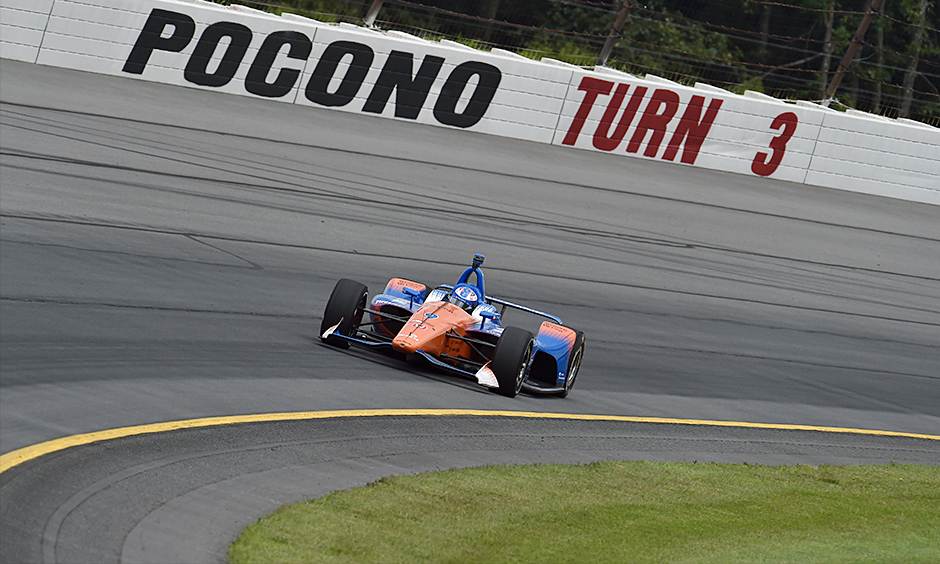Success at Pocono Raceway 'turns' on setup compromise
AUG 19, 2018
The trick is in the negotiation. Or as Scott Dixon and Ryan Hunter-Reay concede further, in the compromise.
At 14 degrees of banking, Turn 1 of Pocono Raceway is an homage to Trenton Speedway and the abrupt end to a 3,740-foot straightaway that is the longest in North America. Race cars become difficult to turn because of understeer.
At 6 degrees, Turn 3 is the absurdly flat “Milwaukee Mile-in-rural-Pennsylvania” culmination of a one-lap oval exercise more demanding than any other in the Verizon IndyCar Series, where the car’s rear is suddenly hard to control because of oversteer.
Turn 2, the so-called “Tunnel Turn” reminiscent of Indianapolis Motor Speedway, is the relative anodyne 9-degree part in the equation. Turns 1 and 3, they are the game. And even as the series has allowed teams the optional use of downforce-adding front-wing extensions and wickers, drivers knew before Firestone tires laid rubber on the track Saturday morning that those turns would again be critical in Sunday’s ABC Supply 500.
“It's very difficult to get (Turns) 1 and 3,” said points leader Scott Dixon, who won in his first Pocono start in 2013 and led 51 laps before finishing sixth last summer. “It takes a lot of compromise, I think, to have a successful race there or even a car that's not too difficult to drive. But I expect it to be pretty similar to last year.
“I think at Indianapolis with the four corners at least – both ends, the two of them being quite close together – we saw the (aero) washout in big packs that disrupted the air and made it a little more difficult, but I was kind of a fan of that because I think you saw the actual really good cars stay at the front. … So I do like the style of racing slightly better.”
Troubles with Turn 1 helped relegate the No. 9 PNC Bank Chip Ganassi Racing Honda driver to a 13th starting slot for the ABC Supply 500, as a bump entering the corner forced a line adjustment that marred his two-lap qualifying run on Saturday. The four-time series champion will have plenty of time to work back through the field, but also several hundred more compromises to make. Dixon, whose two-lap average speed of 216.410 mph was dwarfed by pole-sitter Will Power’s blistering 219.511, said he was generally able to run full throttle in Turns 2 and 3.
INDYCAR introduced the optional aerodynamic pieces this week in an effort to provide the extra bit of downforce needed to make passes in traffic that proved more difficult in this year’s Indianapolis 500 than in recent years. The first-year universal aerodynamic body kit curtailed downforce production, by design and to the general approval of drivers.
Although Indianapolis Motor Speedway and Pocono Raceway share a track length of 2.5 miles and the DNA of Turn 2, they are not the same at all, said 2015-time Pocono winner Ryan Hunter-Reay, who qualified fourth.
“The Pocono race is different than Indy. It is its own beast,” said the Andretti Autosport driver, who crashed in Turn 3 during qualifying last year. “It's very particular in that in Turn 3 with banking, it's a true handling corner, feels almost like a Milwaukee-type of corner, but going twice the speed. You have to set your car up for that. You have to set your car up for Turn 1, which is a massively banked, tight-radius corner. It comes more down to a handling aspect to balance, trying to get the setup right.
“I think we're going to see a different type of race,” added Hunter-Reay, the 2012 series champion. “I don't think it's just going to come down to top-end speed, although that will help at Pocono. I think it's going to be more of a handling race.”
Having won previously at Pocono is most valuable, Hunter-Reay said, in having learned the balance needed to help his team hone another race-winning Honda.
“You know what you're looking for when you're setting up the car in practice and in warmup,” he said. “You know what you need out of it in Turn 3 versus Turn 1, the compromise that's there, because there is a compromise between the two.”
And a long day of them ahead on Sunday.
ABC SUPPLY 500 FAST FACTS
Race 14 of 17 on the 2018 Verizon IndyCar Series schedule
Track: Pocono Raceway, a 2.5-mile triangular oval that has hosted 24 previous Indy cars races, the first in 1971
Race distance: 200 laps/500 miles
Fuel: 130 gallons of Sunoco E85 ethanol for each car
Full fuel stint: 28-32 laps
Television: NBCSN, 1:30 p.m. ET (also available on NBCSports.com and NBC Sports app)
Radio: Advance Auto Parts INDYCAR Radio Network (network affiliates, Sirius 98, XM 209, IndyCar.com, IndyCarRadio.com, INDYCAR Mobile app)






















